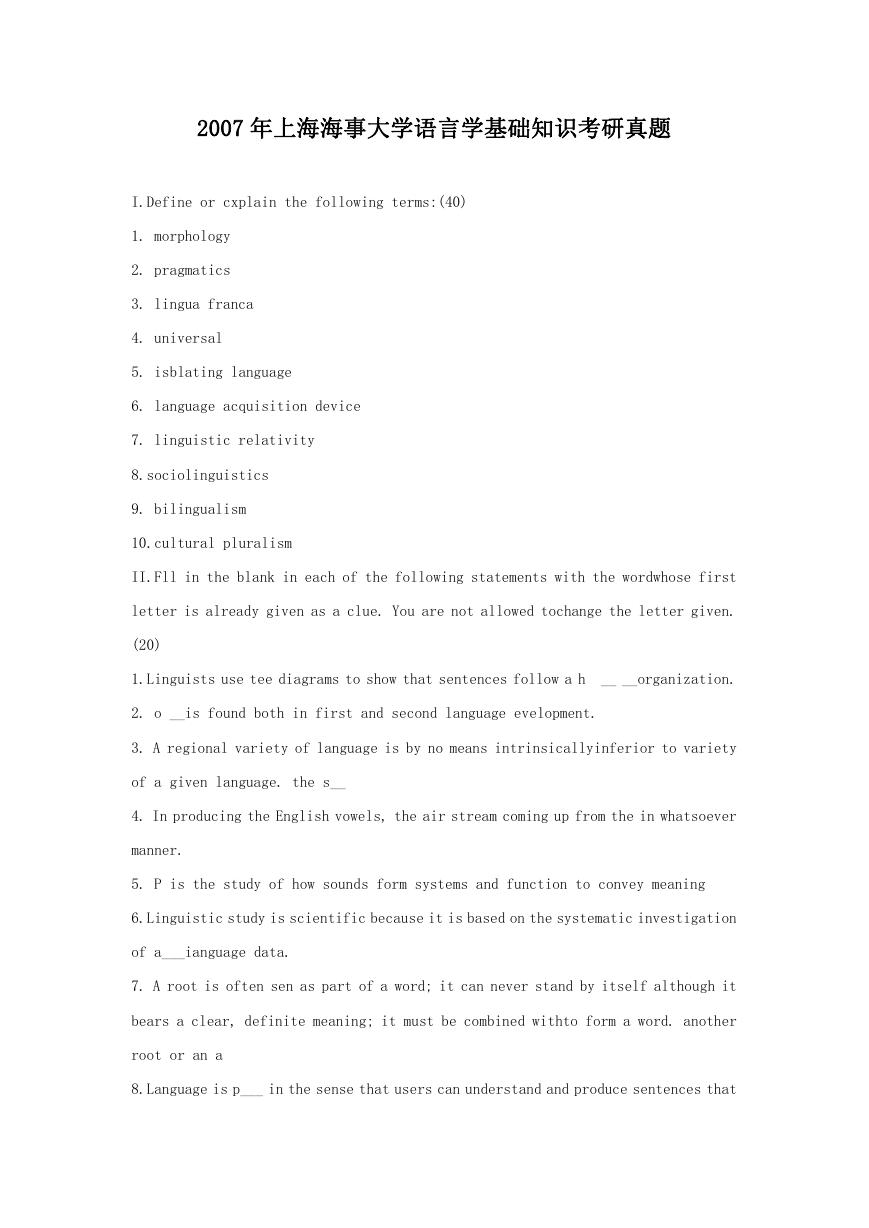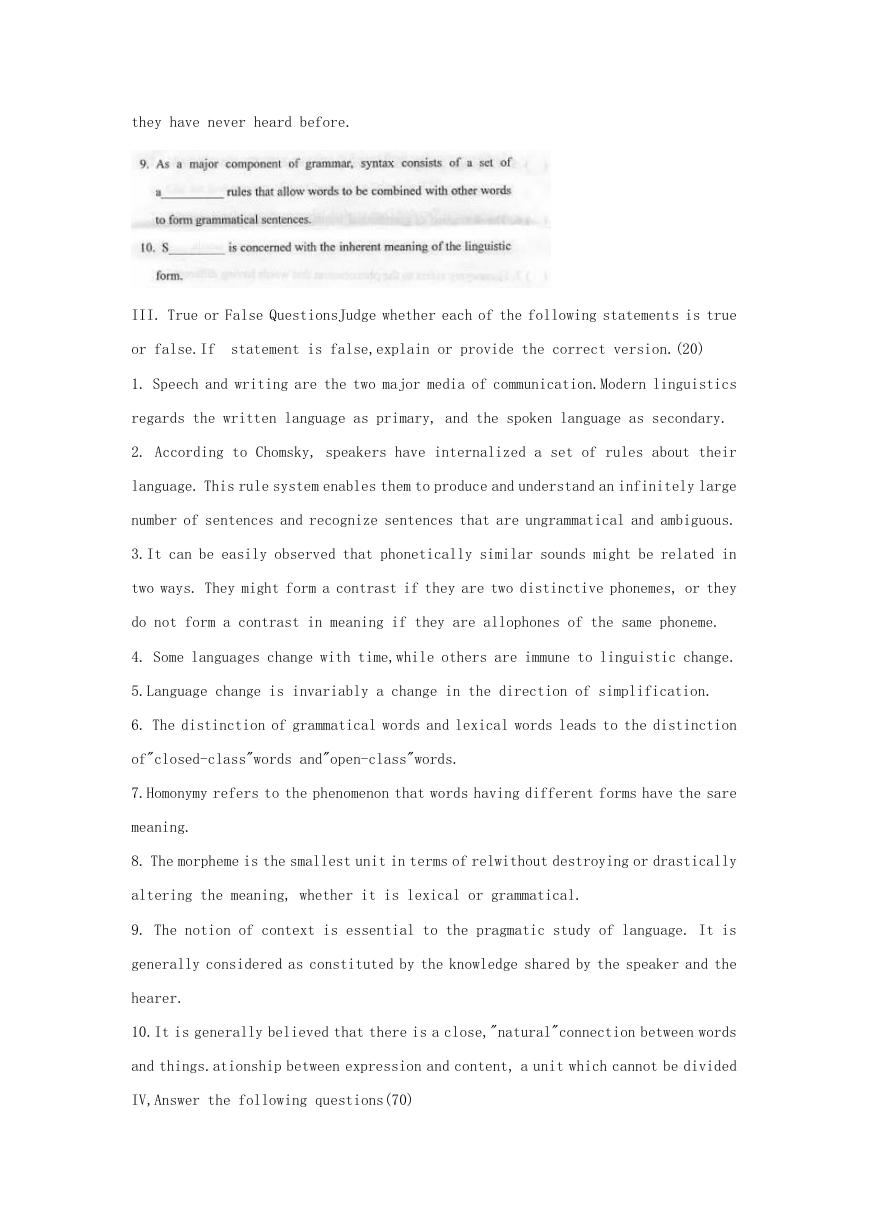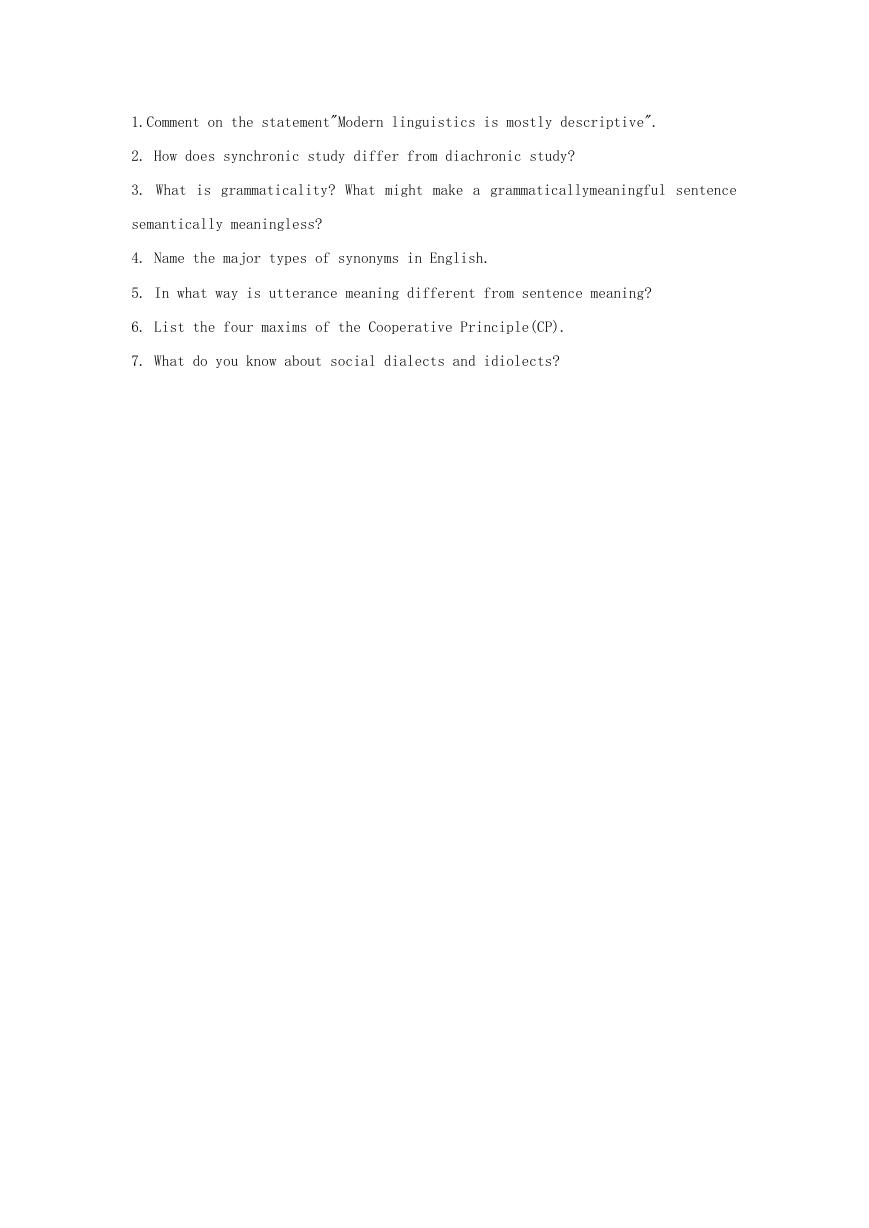2007 年上海海事大学语言学基础知识考研真题
I.Define or cxplain the following terms:(40)
1. morphology
2. pragmatics
3. lingua franca
4. universal
5. isblating language
6. language acquisition device
7. linguistic relativity
8.sociolinguistics
9. bilingualism
10.cultural pluralism
II.Fll in the blank in each of the following statements with the wordwhose first
letter is already given as a clue. You are not allowed tochange the letter given.
(20)
1.Linguists use tee diagrams to show that sentences follow a h
__ __organization.
2. o __is found both in first and second language evelopment.
3. A regional variety of language is by no means intrinsicallyinferior to variety
of a given language. the s__
4. In producing the English vowels, the air stream coming up from the in whatsoever
manner.
5. P is the study of how sounds form systems and function to convey meaning
6.Linguistic study is scientific because it is based on the systematic investigation
of a___ianguage data.
7. A root is often sen as part of a word; it can never stand by itself although it
bears a clear, definite meaning; it must be combined withto form a word. another
root or an a
8.Language is p___ in the sense that users can understand and produce sentences that
�
they have never heard before.
III. True or False QuestionsJudge whether each of the following statements is true
or false.If
statement is false,explain or provide the correct version.(20)
1. Speech and writing are the two major media of communication.Modern linguistics
regards the written language as primary, and the spoken language as secondary.
2. According to Chomsky, speakers have internalized a set of rules about their
language. This rule system enables them to produce and understand an infinitely large
number of sentences and recognize sentences that are ungrammatical and ambiguous.
3.It can be easily observed that phonetically similar sounds might be related in
two ways. They might form a contrast if they are two distinctive phonemes, or they
do not form a contrast in meaning if they are allophones of the same phoneme.
4. Some languages change with time,while others are immune to linguistic change.
5.Language change is invariably a change in the direction of simplification.
6. The distinction of grammatical words and lexical words leads to the distinction
of"closed-class"words and"open-class"words.
7.Homonymy refers to the phenomenon that words having different forms have the sare
meaning.
8. The morpheme is the smallest unit in terms of relwithout destroying or drastically
altering the meaning, whether it is lexical or grammatical.
9. The notion of context is essential to the pragmatic study of language. It is
generally considered as constituted by the knowledge shared by the speaker and the
hearer.
10.It is generally believed that there is a close,"natural"connection between words
and things.ationship between expression and content, a unit which cannot be divided
IV,Answer the following questions(70)
�
1.Comment on the statement"Modern linguistics is mostly descriptive".
2. How does synchronic study differ from diachronic study?
3. What is grammaticality? What might make a grammaticallymeaningful sentence
semantically meaningless?
4. Name the major types of synonyms in English.
5. In what way is utterance meaning different from sentence meaning?
6. List the four maxims of the Cooperative Principle(CP).
7. What do you know about social dialects and idiolects?
�






 2023年江西萍乡中考道德与法治真题及答案.doc
2023年江西萍乡中考道德与法治真题及答案.doc 2012年重庆南川中考生物真题及答案.doc
2012年重庆南川中考生物真题及答案.doc 2013年江西师范大学地理学综合及文艺理论基础考研真题.doc
2013年江西师范大学地理学综合及文艺理论基础考研真题.doc 2020年四川甘孜小升初语文真题及答案I卷.doc
2020年四川甘孜小升初语文真题及答案I卷.doc 2020年注册岩土工程师专业基础考试真题及答案.doc
2020年注册岩土工程师专业基础考试真题及答案.doc 2023-2024学年福建省厦门市九年级上学期数学月考试题及答案.doc
2023-2024学年福建省厦门市九年级上学期数学月考试题及答案.doc 2021-2022学年辽宁省沈阳市大东区九年级上学期语文期末试题及答案.doc
2021-2022学年辽宁省沈阳市大东区九年级上学期语文期末试题及答案.doc 2022-2023学年北京东城区初三第一学期物理期末试卷及答案.doc
2022-2023学年北京东城区初三第一学期物理期末试卷及答案.doc 2018上半年江西教师资格初中地理学科知识与教学能力真题及答案.doc
2018上半年江西教师资格初中地理学科知识与教学能力真题及答案.doc 2012年河北国家公务员申论考试真题及答案-省级.doc
2012年河北国家公务员申论考试真题及答案-省级.doc 2020-2021学年江苏省扬州市江都区邵樊片九年级上学期数学第一次质量检测试题及答案.doc
2020-2021学年江苏省扬州市江都区邵樊片九年级上学期数学第一次质量检测试题及答案.doc 2022下半年黑龙江教师资格证中学综合素质真题及答案.doc
2022下半年黑龙江教师资格证中学综合素质真题及答案.doc